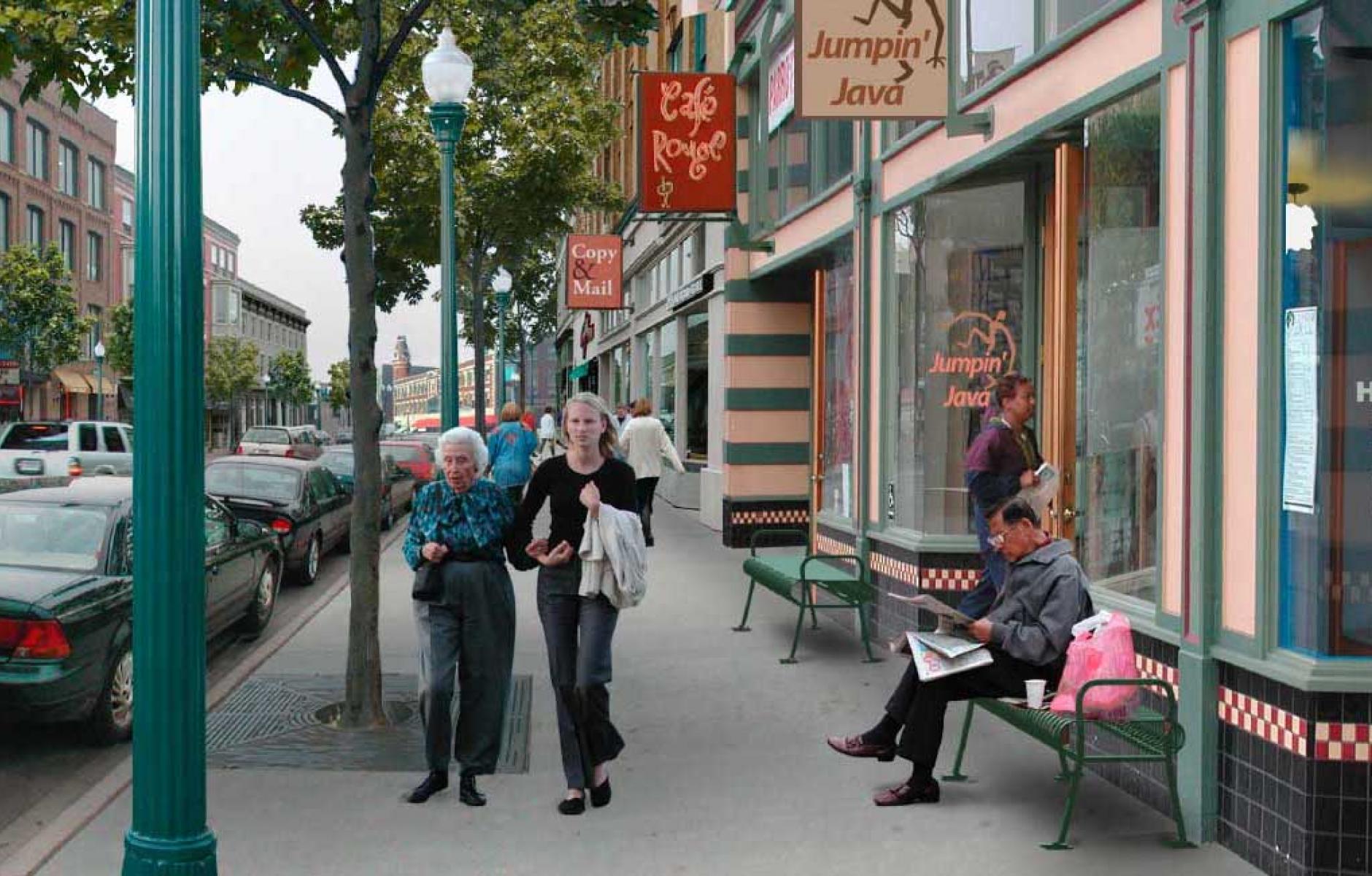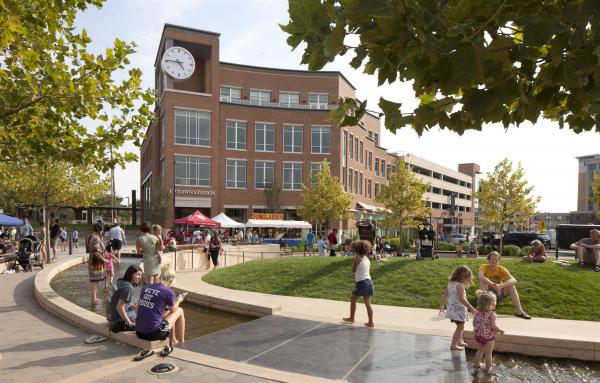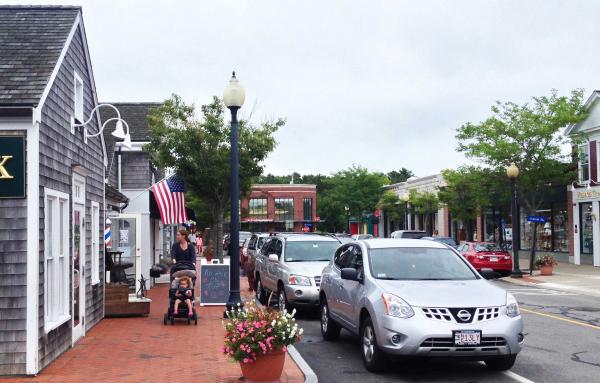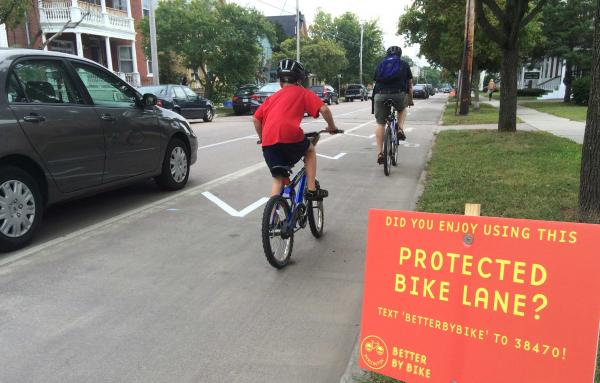
Great idea: Pedestrian shed and the 5-minute walk
In celebration of the upcoming CNU 25.Seattle, Public Square is running the series 25 Great Ideas of the New Urbanism. These ideas have been shaped by new urbanists and continue to influence cities, towns, and suburbs. The series is meant to inspire and challenge those working toward complete communities in the next quarter century.
"Neighborhoods should be compact, pedestrian-friendly, and mixed-use," and "many activities of daily living should be within walking distance," according to the Charter of the New Urbanism. A quarter century ago this idea was not common planning practice, and new urbanists needed a way to measure a compact neighborhood to organize plans and communicate to the public. The answer was the "pedestrian shed," a distance that can be covered in five minutes at a normal walking pace—typically shown on a plan as a circle with a quarter-mile radius.
If the built environment is appealing and human scale, the theory is that most people will walk at least five minutes rather than get in a car. The idea is embedded in a thousand new urban plans and incorporated into zoning codes now. Although the quality of the built environment can expand or shrink the distance people will walk, the quarter-mile pedestrian shed remains an influential and useful idea for designing neighborhoods and building complete communities. Public Square editor Robert Steuteville interviewed urban planner and architect Elizabeth Plater-Zyberk of DPZ, co-author of Suburban Nation and former dean of the University of Miami School of Architecture, and urban planner Jeff Speck of Speck & Associates, former director of design of the National Endowment for the Arts and author of Walkable City and co-author of Suburban Nation, on the subject of the 5-minute walk and what that means to cities and towns across America.

Both of you co-authored, along with Andres Duany, the book Suburban Nation that introduced America to the neighborhood and the pedestrian shed. Can you tell me how planning and development has changed as a result of this idea?
Plater-Zyberk: When we first started talking about walking, everybody was saying, "Oh, nobody's going to walk anywhere." We knew about the BART (Bay Area Rapid Transit) studies in San Francisco, which had surveyed people and discovered that the 5-minute walk was a reasonable expectation for transit. Peter Calthorpe and others have said a 10-minute or more walk is okay for transit. But when the new urbanists were honing in on this, it was not contemporary knowledge. We had never heard of the 1929 regional plan for New York or that 5-minute diagram [by Clarence Perry]. We discovered that much later and it was a kind of confirmation. But I would say these were rediscoveries. Many of the historical experience that we now call on, including maybe even the terminology pedestrian shed, had to be rediscovered because it was lost to most planning and design knowledge.
Speck: By the time I first started working at DPZ, which was the summer of '87, you guys had incorporated the five-minute-walk into your planning. So by the time of my first encounters with you all, it had been established, and you were aware of the 1929 (Perry) diagram.
Plater-Zyberk: Yes, but the first few years, all of that was being rediscovered. Now, how has it affected the planning since then? People have put that dimension of a five minute walk or some pedestrian shed distance into zoning codes. You might have less parking required if you are within a certain distance of a transit line or stop. It's always in discussion. Is this a single circle with one node, or is it running along the line of transit? A leader in the talks about pedestrian distance, Walk Score, has emerged. And although it's not changed the world entirely in great geographic measure, it's definitely become part of the overall goals of making better urbanism. And I would say most planning now makes some reference to pedestrian sheds in goals and regulations.
Speck: I'll be even bolder than Lizz and say that this idea, which was first popularized, or most effectively popularized, by Lizz and Andres [Duany], is now one of the foundational concepts in planning. I just want to distinguish between planning theory that is taught in school and how most of America and most of the world is still being built. The planners have figured it out but, of course, the challenge now is the great disconnection between what planners know and what developers are building, which is still mostly wrong.

Do all urbanists agree now on the five-minute walk, or is there disagreement there?
Speck: There might be nitpicking around the edges, but I don't think there are any urbanists or planners who would question a comfortable walking distance measure as a means for structuring community. Would you agree, Lizz?
Plater-Zyberk: I think anybody who's concerned about the scale of urban design and community beyond one building at a time could agree that this is a good goal.
This may be jumping ahead a little bit, but you've mentioned it, Jeff. Why hasn't this had more of an impact on the America that you see as you drive around?
Speck: Well, that's been our discussion for so many years. All the professions that work together to create the American-built environment have certain conventions. And every profession has written into its practices, or at least used to, the organization of the landscape around Euclidean zoning—large areas of single-use with nary a thought to pedestrian access. So it's a huge ocean liner to turn around, and no one expected it would happen quickly.
Plater-Zyberk: I would add or maybe stress one component of that, which is the scale of economic activity that has emerged as a result of the prevalence of automobile mobility—the big box, the number of brands that rely on drive-ins, fast food, and so on. The scale of the economy is really a very difficult counterpoint. That said, I have spent a bit of time in France in recent years and it is interesting to see big box developed on the outskirts of the walkable city. So there is an understanding that there are places where daily life goes on and you can walk to work and school, and then there are areas for trucks and giant roads. It’s one or the other, not the mess we have tended to allow in the United States.
Speck: We have a development industry that's made principally of people who are either single-family housing developers, multi-family housing developers, retail strip developers, big box developers, office park developers, and the like. And if you give one of them a piece of land, no matter how big the piece of land is, they're going to develop what they know how to do. And to no small measure, it's been the dissection of the development industry into these branches that has made it very hard to get the development industry to start doing mixed-use again.
Plater-Zyberk: You might call it the tyranny of specialization. CNU has talked about specialization and the fact that that it generates bigness.
Do you just give up on things like big box stores, or can they be incorporated into the pedestrian shed?
Plater-Zyberk: Well, Saks Fifth Avenue in New York City is a big box. It's a multi-story big box. They took the whole block. And I think that's one of the best examples of the fact that big box stores used to be part of the city. Market Street in Philadelphia had four department stores, and other stuff in between. I guess New York is pulling them back in, the Walmarts and the Targets.
Speck: Yeah, that's the urban model. Then there’s the suburban model which DPZ helped develop, and you see it in play at Kentlands, where you have big boxes that are accessed from the highway in an automotive way, and accessed from the town in a pedestrian way—and you better believe that folks who live in Kentlands are walking to the big boxes on the edge of town. The question is how do you handle the integration of the building into the streetscape that approaches it? And new urbanists have developed ways to do that.
Do you think that people who have the most influence over the built environment, the planning commissioners—the city councils, the developers— do they now understand the concept of a pedestrian shed? Is it something that has sunk in?
Speck: Many planning commissioners particularly in smaller communities have no training in planning whatsoever, and many developers have no training in planning whatsoever. To the degree that they've never really studied planning or made an effort to learn best practices. No, they have very little idea about it, but there are, of course, many who do.
Plater-Zyberk: So let's say it's not a household word. But whenever we give Suburban Nation to a newly elected person, for instance, they come back and say, "Oh, yeah, I get it." So it's not a rocket-science idea, but it hasn't permeated. And that's primarily because most people don't think about the built environment; they're just victims of it, and they take it the way it comes.
How is this idea used in current planning and how it can be applied most effectively in the future?
Plater-Zyberk: There's two aspects to it. The pedestrian shed is essentially a dimension or a description of an area that enables pedestrian accessibility. But that's not just measuring dimension in quantity, but quality. How frequent are the intersections? How mixed are the uses? What are you accessing? Is the central focus the destination, or it is where you're starting from—your house, for instance?
Speck: In my experience, it's only the new urbanists who, when confronted with a large area of land, their first step is to start drawing pedestrian sheds as a foundational way of organizing property. When I begin a planning effort, I make that move to lay circles on the acreage, like we did at Cornell, outside of Toronto, to create neighborhood units that break the landscape up into constituent parts. And I find that people are really surprised to see that and they say, "Oh, what a great way to organize property." But I honestly don't think that that has permeated the planning culture yet. I don't think this concept of dividing large properties into neighborhoods as a foundational move is practiced that far beyond the new urban circles, no pun intended.

Plater-Zyberk: Now that was a very important point, Jeff. I think this correlation between pedestrian shed and neighborhood is important because that describes the quality of what's going on inside the pedestrian sheds. I would add that it might be useful to think about it in terms of new places and old places. Jeff's description of laying the circles on the paper is the way a greenfield project might be laid out; you structure it according to neighborhoods that are circumscribed by pedestrian sheds. And there may be a larger town center shed that several neighborhoods aggregate to. Of course, we've always been involved in remaking places too. And when you remake urban places, you often find that there was a pedestrian shed and maybe it's fallen apart. The built environment is deteriorated. But when you look at the infrastructure and the buildings that are there you can rebuild that pretty easily. And then there’s suburban sprawl that we built during the last century. You can come in and identify the places where you might be able to retrofit and make a compact pedestrian focus area and the single-family sprawl will remain around it. Very often that's an office park or shopping center or something that's under some coherent ownership that it can be remade. So you could talk about it in terms of new places, pre-existing cities, and then how do you repair the structureless suburbs.
This is basic to the way new urbanists approach planning. Could you talk about some of your current projects and how the pedestrian shed relates to that project and is influencing what's happening there?
Speck: I would say that, as Liz suggested, when you're working in an existing place you have to respect the existing neighborhood structure. Discovering the underlying neighborhood structure can be eye-opening. I remember when we were looking at Syracuse we found neighborhood structure in some of these inner city neighborhoods that have been undermined and almost obliterated by auto-centric development. And a big part of what we did was to let people know where their neighborhood centers were so that policy could be oriented around understanding where those centers are.
Plater-Zyberk: DPZ has been working with some hospital systems to help them plan their property. They often own pieces of property outside their main buildings. The Presence Health system in Chicago, for instance, had two close-by hospitals, and everyone got in their cars to go from one to the other. We showed them that the two pedestrian sheds from their front doors intersected, and if they made improvements in the path between them that people really could walk back and forth, and that they could use those parking lots to make a piece of city that would connect them better. Also, two shopping malls in suburban Salt Lake City, Cottonwood and University Mall, were in the midst of a classic suburban vehicular intersection. We showed them how to remake those malls and their surroundings by adding a mix of uses within the pedestrian shed.
It seems incredibly hard for people to get the concept of a pedestrian shed when you are in the suburbs, where everything is on an automobile scale. How do you get people to understand that when you're working in the suburbs?
Plater-Zyberk: This is where the illustrations for new urbanist ideas are so important because people can't visualize it at all. The first drawings that started to convince people to try something new were done by Charles Barrett, bless his heart, he is no longer with us. The kind of charm and hope that those drawings represent are such an important part of what we do. It's not the diagram—that circle with the arrow from the center to an edge—that will never convince anyone. But the beautiful illustrations, the idea that the architecture might be great, that the street will be appealing, the sidewalk will be wide, there will be trees, and you can take your child out by the hand, or walk a dog on your way somewhere, is what tugs at people’s hearts. (Note: See the illustration by Steve Price at the top of this article)
They can picture themselves within a pedestrian shed, doing something?
Plater-Zyberk: That's exactly right.
Speck: The biggest challenge that we face in the suburbs is that it's not really a pedestrian shed unless it's accessing mixed use. And, for most of us, a town square at the center, perhaps with some sort of civic structure, even if it's nothing more than a barbeque shack, isn't enough to achieve the lifestyle changes that the New Urbanism hopes to provide for humans living in its places, and we always say that, at the bare minimum, you want to have a corner store, and the corner store depends on a certain number of rooftops. I heard once from (planner and retail expert) Bob Gibbs, you've got a thousand homes to make one corner store function. To get that density in a 160-acre pedestrian shed has been the fundamental challenge to New Urbanism.
Plater-Zyberk: If there aren't enough houses for the corner store, then your neighborhood—this pedestrian shed—may join another one. And there may be a kind of congregation of them around a village center or town center that is supported by multiple neighborhoods.
This may seem like a strange question, but as we are speaking, a new president is being inaugurated. So do you have any thoughts on the new administration, Donald Trump, federal programs, and whether this relates to planning on the neighborhoods scale?
Speck: As someone who worked in the federal government, there's only a limited way in which the federal government has ever exerted much influence on the details of planning. But when it has, like with the Hope VI program, which is based entirely on urbanist principles, it certainly had a profound impact. You're not going to see those sort of programs under this sort of administration. But more to the point, the latest talk is about abolishing all transit funding which, of course, is going to be entirely disruptive to any notions of walkability.
Nevertheless, the pedestrian shed has survived many eras and planning ideas. It should survive the next four years, don't you think?
Plater-Zyberk: It will survive. Fortunately, there's so much literature now that the profession will not lose track of it again the way we did in the last century. We've kept it alive in so many ways through building and through literature.
Speck: One of the helpful oversimplifications that I say in my presentations is that the five-minute walk was developed historically. You're getting it from Jericho on, and it was only undermined by the advent of suburbia where we introduced automobile-based zoning. But in fact, if you look at the towns in the early 20th century, that the new urbanists are always pointing at for its successes, such as the Coral Gables, and the Shaker Heights, and Beverly Hills, and all these amazing developments that some refer to as the apex of American planning, none of these really have a five-minute walk pedestrian shed at their core. They have concentrated retail areas and huge areas of residential land. And I think one of the great achievements of New Urbanism is to take the other tremendous intelligence from those plans, the other great techniques that are present in those plans, and combine them with the neighborhood unit, which actually is missing in most of them.
Plater-Zyberk: I like to focus on the things that worked that we can use. Even if you don't have the corner store but if you have something that's defined by its edges and some kind of central place, a neighborhood, even it isn't highly mixed-use, it still gains a sense of community, identity, and the potential of interdependence among a group of people that is beneficial. There's a great deal of hope with regard to the retail component. A new generation of entrepreneurs, in places like Detroit and Miami, are looking for walkable places to [open businesses]—whether it's the coffee shop or the beer joint or a restaurant or a gallery or whatever they're doing. I think there's an ever-growing economy of small business that will look to old city places or to remaking of suburbs. The physical organization of pedestrian sheds in neighborhoods speaks to this generation in the way that setting up a business in a suburban shopping center does not.
Note: CNU intern Benjamin Crowther helped to produce this interview and article.







